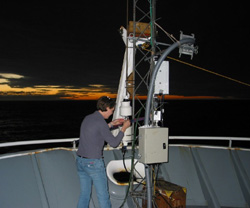Cruise
Log: Sunday, April 4, 2004
|
March
|
|
Sun
|
Mon
|
Tue
|
Wed
|
Thu
|
Fri
|
Sat
|
|
|
1
|
2
|
3
|
4
|
5
|
6
|
|
7
|
8
|
9
|
10
|
11
|
12
|
13
|
|
14
|
15
|
16
|
17
|
18
|
19
|
|
|
|
|
|
|
|
|
|
|
|
|
|
|
|
|
|
|
April
|
|
|
|
|
|
|
|
|
|
4
|
|
|
|
|
|
|
|
|
|
|
|
|
16
|
17
|
|
18
|
19
|
20
|
21
|
22
|
23
|
24
|
|
25
|
26
|
27
|
28
|
29
|
30
|
|
|
| |
 |
Removing
samples from the Berner Impactor (Photo
by Matt Walkington). |
| |
 |
|
CLAW
hypothesis schematic diagram.
|
| |
 |
| Dawn
at dusk (Matt Walkington). |
Dawn
at Dusk
Contributor: Dawn Devries,
NIWA
As previously mentioned,
we took another stab at trying to buff up the phytoplankton by, as Peter
Minnet so eloquently put it, "pumping iron" into the patch yesterday.
We are now waiting to see if the phytoplankton respond to this.
I am involved in the
atmospheric chemistry group (along with Mike Harvey, Jill Cainey, and Murray
Smith), specifically looking at aerosol chemistry. My primary instrument
is a Berner impactor, which samples atmospheric particulate matter by pumping
air through an inlet on the foremast and then separating the particles into
4 different size categories. I will be doing ion chromatography analysis
on the particles when I get back to NIWA to determine the chemical composition
of the aerosols in each size bin.
Although much of this
science may seem very esoteric, there are definite real-world applications
to this study. Specifically, the chemical composition and size distribution
of aerosols has important implications for climate change due to their
effects on cloud formation.
There has been a hypothesis
(the CLAW hypothesis) floating around the scientific community since 1989
that marine phytoplankton can offset global warming. As proposed, higher
ocean temperatures due to global warming would enhance phytoplankton growth
and hence emissions of dimethylsulfide (DMS) into the atmosphere. This
DMS is then readily oxidized to sulfate, which in turn serves as cloud
condensation nuclei (CN), increasing cloud cover and solar reflectivity
and hence cooling the earth.
However, recent
research has shown that a significant amount of these non-sea salt (NSS)
particles often coalesce onto larger particles of sea salt which have
been flung into the air by breaking waves. This greatly reduces the amount
of new particle formation and hence the number of condensation nuclei.
If true, this would reduce the efficiency of the cloud cooling effect.
By better characterizing the chemistry and size distribution of non-sea
salt sulfates, we can help to clarify this phytoplankton feedback. This
will allow global climate modelers to adjust their models to reflect the
reality of this effect. Next Day >>
|